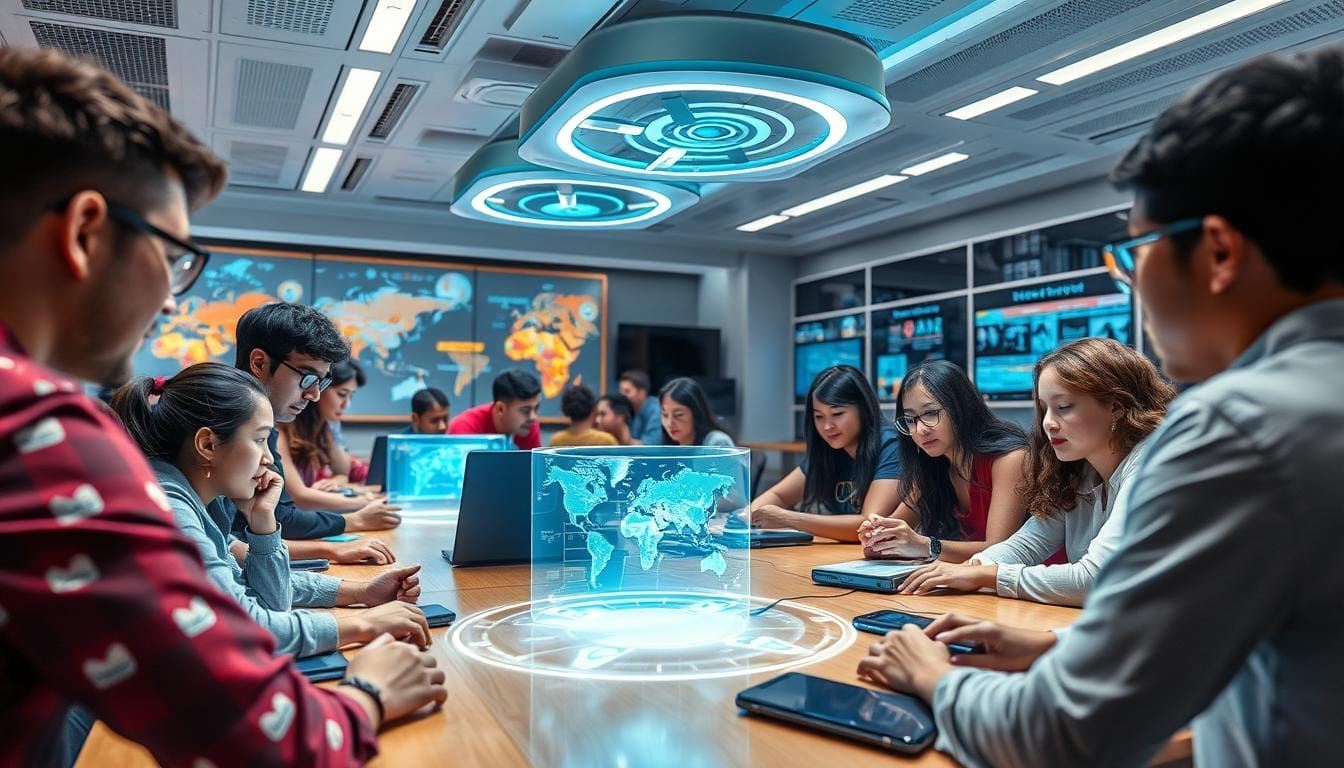In today’s fast-changing job market, keeping up with new skills is key. Technology is changing how we work, and we need to keep up. Luckily, a new tool is coming: persistent virtual environments. They’re changing how we learn and train.
Persistent virtual environments are like interactive, real-life simulations. They let users practice and get feedback right away. These new tools are making learning better and more effective. Goldman Sachs says AR and VR could make $80 billion by 2025. Boeing has already seen better training results with VR.
Key Takeaways
- Persistent virtual environments provide immersive, interactive platforms for continuous skill development.
- These technologies are revolutionizing training and education, with the potential to generate $80 billion in revenue by 2025.
- Leading companies have successfully implemented VR and AR solutions, resulting in improved learning outcomes and increased efficiency.
- Persistent virtual environments offer enhanced accessibility and flexibility, enabling learners to practice and develop skills at their own pace.
- The integration of AI and machine learning in these environments further personalizes the learning experience and optimizes outcomes.
Introduction to Persistent Virtual Environments

A new world is opening up in the digital world – the realm of persistent virtual environments. These spaces mix real and virtual worlds, making learning more fun and real. They are key for learning new skills and keeping learning a lifelong journey.
Definition and Importance
Persistent virtual environments are at the core of the metaverse. They are always there, even when no one is using them. They help people learn new things and keep learning throughout their lives. These spaces are becoming more popular because they make learning easy and accessible for everyone.
Overview of Skill Development
In these virtual spaces, people can dive into adaptive skill-building environments that go beyond old-school learning. These places are perfect for learning new things, working together, and getting feedback. They use virtual reality and new tech to help people keep learning and growing.
| Key Metaverse Statistics | Value |
|---|---|
| Metaverse market value (2024) | $74.4 billion |
| Metaverse market value (2030) | $507.8 billion |
| Metaverse commerce market value (2030) | $5 trillion |
| Metaverse users (2024) | Over 2.6 billion |
“The Metaverse is the next frontier in connectivity, where people can interact, work, and play in a convergence of our physical and digital lives.”
The Benefits of Using Virtual Environments

Interactive virtual worlds are changing how we learn. They offer many benefits that are making skill building better for everyone. These environments are key in today’s fast-paced world.
Enhanced Learning Experiences
Virtual worlds let learners practice in a safe space. For example, Osso VR has cut surgical training time by up to 35%. This shows how virtual reality can make learning more effective.
Studies say learning in 3D environments can boost memory by up to 300%. This makes virtual learning more engaging and memorable.
Accessibility and Flexibility
Virtual environments also make learning more accessible and flexible. Walmart saw a 10% boost in task efficiency with augmented reality training. This shows how virtual coaching can help a lot.
These environments remove physical barriers and let people train anytime, anywhere. This makes them very valuable in today’s fast-changing job market.
Using interactive virtual worlds opens up new ways to learn and grow. As these technologies improve, so will the benefits. This will help both individuals and businesses succeed in the digital world.
How Persistent Environments Support Continuous Development
Persistent virtual environments are changing how we learn and grow. They create immersive digital spaces for long-term learning. This helps people master new skills and keep improving their knowledge.
Long-Term Engagement
These environments keep learners engaged for a long time. They make users feel like they own their learning journey. With personalized learning paths and feedback, they adapt to each person’s needs.
Adaptive Learning Opportunities
Persistent virtual environments are great because they adjust to what learners need. They analyze how well someone is doing and change the learning experience. For example, a University of Illinois study showed a 30% better understanding and retention in engineering classes using VR.
| Benefit | Description | Outcome |
|---|---|---|
| Skill Mastery Simulations | Persistent virtual environments provide immersive, hands-on experiences that allow learners to practice and refine their skills in a risk-free, simulated setting. | Increased competence, confidence, and ability to apply skills in real-world scenarios. |
| Continuous Professional Development | These environments enable ongoing skill development, allowing learners to stay up-to-date with industry trends, acquire new capabilities, and adapt to evolving job requirements. | Enhanced career progression, increased job security, and improved overall employability. |
By using persistent virtual environments, both organizations and individuals can reach their full learning and growth. This creates a culture of lifelong learning and adaptability in our changing world.
Key Features of Effective Virtual Environments
Immersive virtual environments are changing how we learn and grow. They use interactive tools and resources for real-time learning. This makes learning fun and engaging.
These environments use new technologies to improve skill learning. They help both individuals and organizations grow.
Interactive Tools and Resources
These environments have many interactive features. They include AI avatars and customizable modules. These help users learn in a way that fits them.
For example, a VR program for surgery uses advanced tech. It makes learning feel real and hands-on.
Real-Time Collaboration Capabilities
Virtual environments now support real-time learning together. Users can talk, gesture, and work together in shared spaces. This makes learning more fun and helps build a community.
For example, a VR program for emergency teams. It lets users practice teamwork in real-time. This prepares them for urgent situations.
| Feature | Benefit |
|---|---|
| AI-powered avatars | Provide context-aware responses, enriching the learning experience |
| Dynamic gesture adaptation | Supports more natural and intuitive interactions in the virtual world |
| Customizable modules | Allow learners to personalize their skill-building paths |
| Real-time collaboration tools | Enable interactive and engaging learning through shared virtual spaces |
These features make virtual environments powerful for learning. They offer experiential learning ecosystems for skill development. As virtual reality training gets better, learning will become even more effective and accessible.
The Role of Gamification in Learning
Gamification is a powerful tool in virtual learning. It makes learning fun and keeps learners engaged. By using elements like points and badges, it makes learning a game. This approach boosts motivation and skill-building.
Motivation Through Game Elements
Studies show gamification boosts employee engagement and knowledge retention. A Learning Solutions Magazine study found a 24% increase in engagement. Training Industry’s survey showed 78% of employees want a more game-like workplace.
Measuring Progress and Achievement
Gamified learning tracks progress and achievement clearly. Aberdeen Group found a 19% increase in employee satisfaction. Deloitte’s study showed a 34% increase in skill development with gamification.
In special education, gamification is very effective. Over 3,800 schools use gamification tools from Insights to Behavior. It improves social skills in students with ASD and boosts reading in dyslexic students.
Gamification in virtual learning boosts motivation and tracks progress. It creates engaging, adaptive, and measurable learning experiences.
| Metric | Improvement with Gamification |
|---|---|
| Employee Engagement | 24% increase |
| Knowledge Retention | 46% improvement |
| Employee Productivity | 78% would be more productive |
| Employee Satisfaction | 19% increase |
| Skill Development | 34% increase |
“Incorporating game-like elements into learning environments can significantly enhance engagement, motivation, and measurable skill development.”
Case Studies: Successful Implementation
Virtual environments have shown their power in both corporate and educational settings. They are changing how we train and develop skills. This leads to better performance and more engagement.
Corporate Training Examples
Walmart, a global retail giant, started a virtual reality (VR) training program in 2017. They aimed to improve the customer experience. The results were impressive, with a 10% boost in customer satisfaction scores.
In finance, big companies have seen great returns from extended reality (XR) technologies. A survey showed 92% of finance professionals saw a positive return on investment from XR two years after starting. Also, 82% think their company will use XR in the next 5 years.
Educational Institutions Leveraging Technology
Virtual environments are also making a big impact in schools. For example, Case Western Reserve University’s “HoloAnatomy” AR platform improved student performance by 20%. This shows how immersive tech can change learning.
These examples show how virtual environments work well in different areas. From retail and finance to education, they help people learn and grow. They make skills development more effective and engaging.
| Sector | Implementation Example | Key Outcome |
|---|---|---|
| Retail | Walmart’s VR training program | 10% increase in customer satisfaction |
| Finance | XR technology adoption in financial firms | 92% of professionals experienced positive ROI within 2 years |
| Education | Case Western Reserve University’s “HoloAnatomy” AR platform | 20% improvement in student performance |
Tips for Creating an Effective Virtual Environment
The rise of interactive virtual worlds and skill mastery simulations is changing how we learn. Creating a virtual space that is engaging and effective is key. Here are some tips to make your virtual training and development programs successful:
Selecting the Right Platform
When picking a virtual platform, look for ones that are easy to use. They should offer features like real-time collaboration and personalized learning paths. Also, make sure they provide analytics to track progress. Working with experienced virtual content developers can help you use the latest tech and meet your specific needs.
Designing Engaging Content
Making virtual content engaging is all about balance. You need interactivity, realism, and clear goals. Use simulations, gamification, and hands-on activities to help learners understand and remember. Always ask for feedback to improve and keep the content relevant and effective.
For example, Boeing used augmented reality in their manufacturing. They focused on training and support to make it work well. This approach improved productivity and cut down on mistakes.
| Virtual Collaboration Tools | Adoption Rate among ICT Teams |
|---|---|
| Video Conferencing | 94% |
| Document Collaboration | 86% |
| Project Management Software | 78% |
| Cloud Storage Services | 92% |
| Virtual Whiteboards | 83% |
| Screen Sharing Software | 69% |
| Time Zone Converters | 56% |
By choosing the right platform and creating engaging content, you can fully benefit from interactive virtual worlds and skill mastery simulations. This can revolutionize learning and development in your organization.
Challenges Associated with Virtual Learning
Virtual learning is becoming more popular for skill development. But, there are challenges that need to be tackled. Technical issues and keeping users engaged are two major hurdles.
Technical Difficulties and Solutions
A PwC study showed that 40% of employees felt sick during VR training. This highlights the need for careful testing and easy-to-use designs. Companies must test thoroughly and include breaks in VR training to ensure a smooth experience.
Maintaining User Engagement
Keeping learners interested in virtual environments is tough. Companies need to create engaging, interactive content. They should also offer ongoing support to keep users motivated.
| Challenge | Solution |
|---|---|
| Motion sickness in VR training | Thorough testing and incorporating breaks |
| Maintaining user engagement | Dynamic, interactive content and ongoing support |
| Resistance and confusion with new technologies | Encouraging feedback and continuous improvement |
By tackling these challenges, organizations can make virtual learning more effective. Overcoming technical issues and keeping users engaged are essential. This will help unlock the full benefits of these innovative learning tools.
Future Trends in Skill Development
The world of work is changing fast, and we need new ways to learn skills. New tech like artificial intelligence (AI) and virtual reality (VR) will change how we learn. They will make learning platforms and ecosystems better.
AI and Machine Learning Integration
AI is key to the future of learning. Companies see AI’s value in improving their training. Eilert Hanoa, CEO of Kahoot!, says AI will make creating materials and analyzing results better.
AI and machine learning will make learning more personal. They will help find skill gaps. This means companies can stay ahead.
Virtual Reality Advancements
Virtual reality is changing how we learn. It offers real learning experiences. Experts say VR training will grow fast, with a 41.2% CAGR by 2031.
As VR gets better, learning will feel more real. We’ll get better feedback and simulations. This will make learning ecosystems better.
AI, machine learning, and VR are changing learning. They make it more personal and immersive. By using these techs, companies can help employees grow in a changing world.
Evaluating Success in Skill Development
Measuring the impact of virtual environments on professional development needs a strategic plan. This plan should include clear metrics and feedback systems. This way, organizations can understand how well their virtual coaching works. They can then make smart choices to improve learning and results.
Metrics for Measuring Progress
Important indicators for skill development in virtual settings include completion rates and time-to-proficiency. Also, seeing how well skills are used in real life matters. For example, Pfizer saw a 50% boost in knowledge retention with VR simulations in their training. This shows how vital it is to measure the effects of new learning methods.
Feedback Mechanisms
- Give learners feedback in real-time to help them grow.
- Collect feedback from learners through surveys, focus groups, or one-on-ones. This helps understand their experiences and what they need to improve.
- Use data analytics to track how learners engage and what they learn. This helps make informed decisions and offer personalized support.
| Metric | Benefit | Example |
|---|---|---|
| Completion Rates | Shows learner commitment and engagement | Learners in VR environments finish courses four times faster than in classrooms. |
| Time-to-Proficiency | Checks how quickly skills are learned | VR training keeps 80% of information, compared to 20% in traditional methods. |
| Application of Skills | Sees the real-world effect of training | A VR module on customer service boosted confidence by 40% and sales by 24%. |
By using these insights, organizations can keep improving their professional development plans. They can make sure their virtual coaching programs really help learners and the company.
“VR training can improve surgical skill retention by 230% compared to traditional methods.”
Conclusion: Embracing Technology for Growth
Using persistent virtual environments for learning is a big change for companies. These tools make learning more immersive, personal, and ongoing. As we go forward, using virtual reality, augmented reality, and artificial intelligence in learning will get easier and more common.
The Path Forward in Skill Development
Companies that use these new technologies will stay ahead in a fast-changing world. They will keep up with new skills and stay competitive globally. Delta Airlines, IBM, and AT&T are already seeing big improvements in training thanks to these tools.
Encouraging Lifelong Learning through Innovation
It’s key for both companies and individuals to use these virtual environments for learning. They help learners feel more confident and engaged. This is important as the job market keeps changing, and we need to stay ready with the right skills.
FAQ
Q: What are persistent virtual environments?
A: Persistent virtual environments are shared online spaces that mix real and virtual worlds. They last over time, work together smoothly, and let users add their own content.
Q: How do persistent virtual environments support continuous skill development?
A: These environments offer deep, interactive learning that goes beyond old-school methods. They help learners grow continuously, adapt to new skills, and support lifelong learning. Users can practice complex skills and get feedback right away.
Q: What are the key benefits of using virtual environments for skill development?
A: Virtual environments make learning better with immersive simulations. They’re easy to access and flexible, leading to better retention of what’s learned.
Q: How do persistent virtual environments support continuous development?
A: These environments keep learners engaged for the long haul. They offer learning that adapts to each person, with feedback in real-time. This helps learners grow at their own pace.
Q: What are the key features of effective virtual learning environments?
A: Good virtual environments have tools and resources that interact with users. They often use AI, like smart avatars, to make learning more real and engaging.
Q: How does gamification enhance virtual learning experiences?
A: Gamification makes learning fun by adding game elements like points and badges. It motivates learners and shows progress clearly.
Q: Can you provide examples of successful implementation of persistent virtual environments?
A: Yes, they work well in both business and schools. For example, Walmart’s VR training boosted customer satisfaction by 10%. At Case Western Reserve University, an AR platform improved student scores by 20%.
Q: What are the key considerations when creating an effective virtual environment?
A: Creating a good virtual environment means choosing the right platform and designing engaging content. It’s important to have clear goals and measure success. Working with experienced developers and listening to user feedback is key.
Q: What are the challenges associated with virtual learning environments?
A: Challenges include technical issues like motion sickness and keeping learners interested. To solve these, test thoroughly, include breaks, and make content dynamic and interactive. Offer ongoing support too.
Q: What are the future trends in skill development using virtual environments?
A: Future trends include using AI and machine learning for more tailored learning. Predictive analytics and automated content curation will also play a big role. Advances in VR technology will make simulations more realistic and haptic feedback better.
Q: How can the success of skill development in virtual environments be evaluated?
A: Success can be measured by looking at completion rates, how quickly learners become proficient, and how well they apply what they’ve learned. It’s also important to have feedback systems that give learners constructive input right away.





